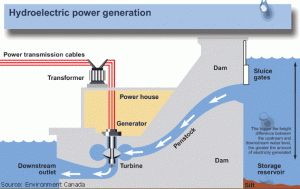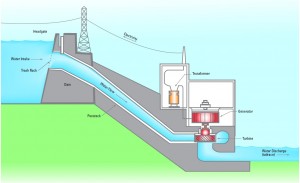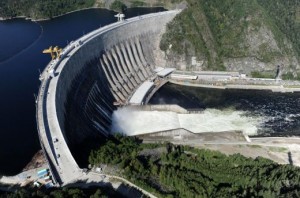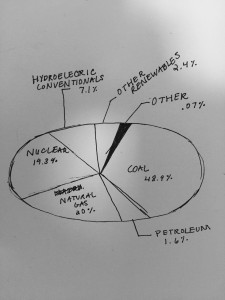Hydroelectric energy is the process of creating energy through water. Falling water turns a turbine, which then turns a part of the generator and creates electricity. A damn is constructed near an area with a large drop in elevation. The damn stores large amounts of water in the reservoir, the water flows through the penstock and a turbine propellor is turned by the moving water and the energy collects to a generator. Power lines are connected to the generator which carries electricity to homes.
“China is the largest producer of hydroelectricity, followed by Canada, Brazil, and the United States (Source: Energy Information Administration)”. Hydropower represents 19% of total electricity production.
Some pro’s of the use of Hydroelectric Power are that fuel is not burned so there is minimal pollution, water to run the power plant is provided by nature, it plays a major role in reducing greenhouse gas emissions, there is a relatively low operations and maintenance costs, the technology is reliable and proven over time and it’s renewable. In comparison, coal and oil fuels use up valuable and limited natural resources and produce a lot of pollution and present waste disposal problems.
Cons of the Hydroelectric system are high investment costs (“In 2014 Russian US invested $2.6 billion to help put 3,000-M-W Boguchany hydroelectric power plant online”), dependent on precipitation, can cause inundation of land and wildlife habitat, can cause loss or modification of fish habitat, fish entrainment or passage restriction, can cause changes in reservoir and stream water quality and can cause displacement of local populations.
“In May 2015, Earthquakes and landslides exposed Hydropower Vulnerability in Nepal. The vulnerability was hinted at during last year’s monsoon as a devastating landslide on Aug. 2 put five hydroelectric power plants out of commission, taking 66.5 megawatts of generation out of our national grid. This loss added one and a half hours of extra daily brownouts – periods when grid managers shut down some power to avoid bigger blackouts”. This is why the geography of Hydroelectric Power Plants is important. Natural disasters put nations at risk when they destroy the power plants.
http://water.usgs.gov/edu/wuhy.html
http://brightmags.com/how-does-hydroelectric-power-work/
http://www.eia.gov/beta/international/
Newspaper Sources:
http://www.hydroworld.com/articles/2014/12/russian-us-2-6-billion-investment-helps-put-3-000-mw-boguchany-hydroelectric-power-plant-online.html



